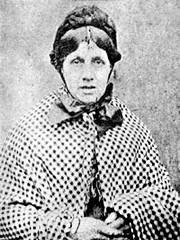Stephen Dee Richards: The "Nebraska Fiend"
In 1876, Stephen Dee Richards left his home and his family in Ohio to go west in hopes of finding wealth. Within two weeks of arriving in Nebraska, he would commit his first murder, with eight more to follow. This would go on to give him the title as the first serial killer in Nebraska.
Born in 1856 in West Virginia, his family would move multiple times throughout Ohio before settling in Mount Pleasant, a Quaker Village. Until the age of twenty, Richards lived with his parents working on various farms. He would eventually become engaged to a woman named Anna Millhorne, but it appears that they never married. They would however remain in usual correspondence to each other up until his final arrest.
In 1876, Richards decided to go westward to find fame and fortune. He first lived in Iowa where he would work as a farmhand for a while. He then took a position at the Iowa Lunatic Asylum, where his job was to bury deceased patients. Richards recalled later that he could watch people die and not feel a thing.
After leaving the asylum, he fell into a life of crime. After arriving in Kearny, Nebraska, he admitted to killing his first victim within two weeks. After meeting a man in the countryside of Nebraska, the two played cards in smaller towns, where Richard took almost every cent the other man possessed.
The two men set off for Kearny after a night of playing cards and the man demanded his money back from Richards. When he refused, he killed the man and dumped his body in a river. He would then kill a friend of the man a few days later, thinking it would be safest to kill him as well.
His third killing came when he’d bought a horse and buggy with counterfeit money. When the seller realized this, he tracked down Richards and demanded either real money, or the return of his horse and buggy. Richards shot him, then buried him after the man threatened to contact the police. In March 1877, he killed a man for waking him up too early. The man, whose surname was Gremge, woke him up at 3 a.m. and Richards shot him after an argument.
He was arrested soon after for the murder of Peter Gateway, a crime he was acquitted for. In June 1878, Richards was in jail for larceny and reunited with a woman he’d met named Mary Harlson. The pair met when he was traveling after the murders of the man he played cards with and his friend. Harlson’s husband was a well-known train robber and she herself was in jail for aiding in the escape of prisoners. They made an agreement that he would buy the deed to her land for $600.
On October 18, 1878, he would arrive at the Harlson’s homestead and would eventually marry Mary. In November, Richards killed Mary and her three children with an ax, worried her talkative nature would expose his crimes. They were found on December 11. Richards claimed he buried them, but others say they were found under hay.
Using one of the many aliases he’d acquired over the years, Richards, who called himself Dick Richardson, began working on Peter Anderson’s farm. Anderson believed Richards poisoned him after becoming ill eating a meal Richards had prepared. He expressed this concern to a neighbor. The two men wold eventually get into an altercation and how he killed him isn’t exactly agreed upon, but it is rumored to have been with hammer, hatchet, or a gun.
He fled after neighbors began asking questions about Anderson’s absence. Nebraska Governor Silas Garber offered $200 to anyone who had information on his whereabouts. He traveled by horse, train, and foot through Omaha, Chicago, and other places on his way back to Mount Pleasant. He eventually met up with Jasper Harlson and his fellow escapee. The three men traveled through numerous states together before arriving in Richard’s hometown, where he would soon be apprehended.
After his arrest, he was jailed in Stubenville, Ohio and wrote two articles for local papers, confessing to nine killings over a span of three years. He was eventually taken back to Nebraska by two county sheriff’s that tracked him down to Ohio. Richard’s trial began in January 1879, and was charged on two counts of first-degree murder. Only after two hours of deliberation, the jury found him guilty and he was set to be executed by hanging on April 26, 1879.
Spectators at his execution are rumored to have been between 2,000 and 25,000. At 1 p.m., he was walked to the gallows and spoke about how he was wrongly convicted, and ready to meet Christ. At 1:17, he was hanged. The St. Louis Globe Democrat claimed it took 15 minutes for him to die.
After his death, Richard’s body was stolen the night after his execution, although it was returned. It was dug up again however and his bones were spread across the streets of Kearny. The Kearny County Gazette reported they had obtained his skull in October 1882, displaying it in their office window.






